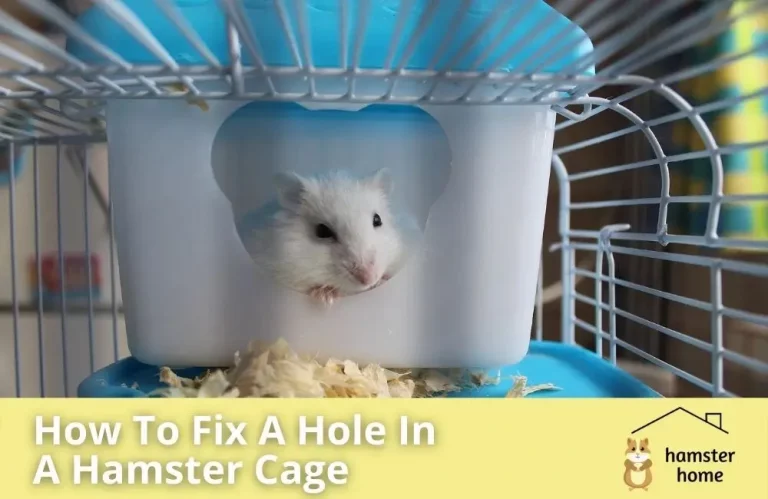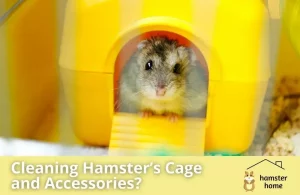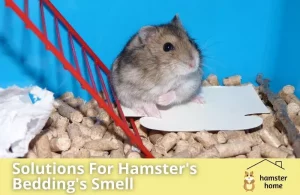An inconvenient hole in the hamster’s cage is not an uncommon sight. However, it does not put an end to the general use of the cage. Most holes in your hammy’s cage can be easily repaired and you can continue using the cage for several more years. Right from using duct tape to bolts, plastic patches, and much more –you can easily fix such holes in no time.
You can make use of several techniques for fixing holes in cages. The techniques apply to both the holes that are chewed upon by the animal and the ones created by manufacturers (some holes are created on purpose).
how to fix a hole in a hamster cage – you can fix a hole in a hamster cage in multiple ways, you can use duct tape, bolts (for small holes), or plastic patches. all of these options will be explained later in the article
Why Do Hamsters Chew or Bite Through a Cage?
Hamsters are known for their sharp teeth. Therefore, they are always desperate to gnaw their teeth or grind something down with them. Hamsters always keep looking for something to chew on. As such, the sides of the cage (especially the plastic ones) offer them ample opportunities to chew on something in case they do not come across anything else to chew on.
While biting through the cage material, the plastic gets gnawed in most instances. As a result, you can frequently come across holes in a hammy’s cage.
How to Patch Up a Hamster Cage?
Patching up the hamster’s cage is one of the most effective methods of repairing a broken cage or the one with a hole. You can make use of a single or dual plastic patch to cover the hole made. Make sure that you are securing it for maximum protection.
How to Repair the Hamster’s Cage?
In case your pet has managed to gnaw through and create a significantly-sized hole in the plastic material, it is important to fix the same as soon as possible. Otherwise, your little creature will keep on widening the hole. Ultimately, you might have to purchase a new cage altogether.
Some of the effective ways in which you can fix the holes on your hamster’s cage are:
Duct Tapes
This technique can be used for very small holes –around 1-2mm. These are perfect solutions for the pre-drilled holes –usually made by manufacturers. Most manufacturers tend to pre-drill the holes for different reasons –like attaching a wheel.
It is found that when a hamster is not able to smell the outside world through the base of the cage, then they are much less likely to chew the material of the cage. Therefore, you can also consider putting duct tape on both outside the hole and the base of the cage. Moreover, such a technique is best applied for the creature that is slightly laid back and not the one who would chew in a hole all over again.
Bolts
For holes that might be around 1-2 cm in dimensions, a bolt & washer can be useful. It is an effective DIY method for securing your pet’s cage and preventing further damage to the cage. There are several ways in which you can make use of bolts and washers for mending the cage with holes:
- A bolt on chew or toy like a coop cup blocking the pre-made water bottle hole
- A plain bolt with two washers –one outside and one inside
- Using the toy or washer and some wires.
Plastic Patches
In some cases, the hole might be too big or out of shape, or even both. In the given situation, you can make use of plastic patches.
Firstly, you should cut the plastic into proper sizes. Just make sure that they are big enough to accommodate and cover the hole that has been made. You can cut two plastic patches –one for the outside and the other for the inside of the cage.
Prefer not to use any glue on the cage. You can think of using a soldering iron for melting the edges of the plastic patch. As you allow it to slowly melt, then you can pause to let the molten areas cool down to stick directly to the cage. It is recommended to be slightly careful in the process as you will be dealing with hot objects. Also, ensure that your pets and kids are out of the working zone.
Additionally, you should take care to not melt the cage too much with the overall heat. It would only create further holes. If you are not sure of this process, you can go ahead with the glue mechanism.
The best suggestion is to regularly keep looking for any small patch or scratch that your hamster might be creating. These patches could eventually lead to larger holes. Therefore, if you find that your hamster is chewing on a particular area of the cage, you can make use of remedial methods initially to save yourself the overall efforts.
Can a Hamster Chew Through a Plastic Cage?
Yes. Hamsters are used to chewing on anything and everything. Therefore, plastic cages are no big surprise for them. In case your hamster is doing it repeatedly causing harm to the cage and its surroundings, then you should take remedial steps right away.
Some reasons why a hamster might chew on the plastic cage are:
- Small Cage: In case the cage is too small, hamsters might feel trapped. Therefore, they might chew on the cage to get out of the same.
- Growing Teeth: Hammy’s teeth keep growing continuously. The four front teeth of these creatures grow throughout their lifespan. Therefore, when it is the teething period, they might feel agitated. Thus, they can chew upon the hard material of the plastic cage.
- Stress or Anxiety: In case your pet is not comfortable in its surrounding, it might feel scared and stressed. As such, to cope up with the situation, he might chew on the cage.
Conclusion
As you think of ways to fix the holes in your hamster’s cage, it is equally important to address the reasons why the creature is exhibiting this behavior. Have a fun time with your pet!
If your hamster is hyper-active, you should refrain from using duct tape. Otherwise, your pet could end up eating it altogether. You can try out other options.
It is doubtful that hamsters might chew through acrylic -unless you will put in some grooves for them to chew upon. In case you are using too much glue, make sure that it is non-toxic.
Most hamster cages are made out of plastic. These cages are made too small to accommodate your beloved pet. This might cause your little one to get agitated soon and feel irritated. Therefore, look for a comfortable cage with ample space for the animal to move around.
Yes indeed. Hamsters are known to wear down their teeth quite often as these keep growing. Therefore, plastic cages can be an easy target for these creatures.






